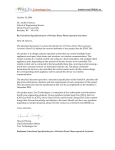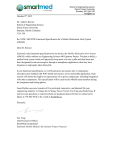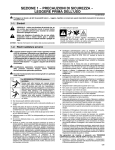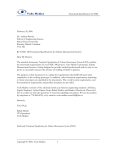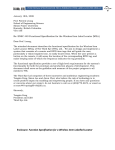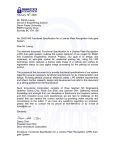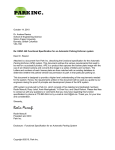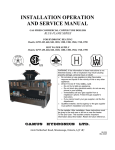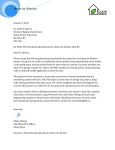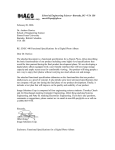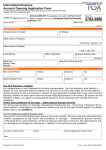Download Functional Specifications - School of Engineering Science
Transcript
February 20, 2006 Dr. Andrew Rawicz School of Engineering Science Simon Fraser University Burnaby, British Columbia V5A 1S6 Re: ENSC 440 – Functional Specifications for a Wireless Cell Phone Docking Station Dear Dr. Rawicz: The attached document, Functional Specifications for a Wireless Cell Phone Docking Station, is written by Websa Technology Ltd and describes the functional requirements for our Wireless Mobile-Dock system. We are developing a mobile phone to home phone communication system which allows the user to dock his or her cell phone and use normal corded or cordless home phones to make and receive cellular phone calls. This functional specification outlines a set of high-level requirements and goals for system functionality at the proof-of-concept phase, production phase, and future development phase of the system. The specification and test plans for each individual module are also included and our design team will use this document as the basis for research and development. Websa Technology consists of five talented, innovative, and dedicated fifth-year engineering students: Wilson Kwong (CEO), Andy Leung (CFO), Stephen Au-Yeung (COO), Edwin Wong (CTO-Hardware) and Bobby Ho (CTO-Software). If you have any questions about this document, or the project in general, please feel free to contact us at [email protected]. Thank you. Sincerely, Wilson Kwong Chief Executive Officer Websa Technology Ltd. Enclosure: Functional Specifications for a Wireless Cell Phone Docking Station Functional Specifications for a Wireless Cell Phone Docking Station Executive Summary Imagine being able to use your cell phone like you would with a normal telephone. Imagine the ability to just pick up the phone and dial without having to worry about poor reception or running out of batteries. Websa Technology Ltd. has the perfect solution with the development of the Wireless Mobile-Dock, a docking station which allows one to dock his/her cell phone and use normal corded or cordless home phones to make and receive cellular phone calls. The functional specifications here-contained will be comparable to current market products. The project itself is divided into three phases: The proof-of-concept prototype phase, the production ready phase, and the future expansion phase. The proof-of-concept prototype will possess the following features: 1) Ability to interface with a cell phone. 2) Ability to interface with a normal corded telephone. 3) Wireless transmission capability between cell phone base station and corded telephone receiver station. The production model will include all prototype features, as well as: 1) Complete printed circuit board (PCB) fabrication in a compact and attractive package. 2) Docking adapters for various cell phone models. 3) Various indication lights to inform the user of system behaviors. 4) Intuitive and easy to understand user interfacing. 5) A User’s Manual. Finally, the features considered for future expansion are: 1) Ability to dock more than one cell phone at the base station module. 2) Use of central routing to interface between base station and multiple corded/cordless handsets around the home or office. A proof-of-concept prototype of the Wireless Mobile-Dock system will be completed by April 2006. Copyright © 2006, Websa Technology Ltd. ii Functional Specifications for a Wireless Cell Phone Docking Station Table of Contents EXECUTIVE SUMMARY ....................................................................................................... II TABLE OF CONTENTS ........................................................................................................ III LIST OF FIGURES ............................................................................................................... IV GLOSSARY ......................................................................................................................... IV 1 1.1 1.2 1.3 INTRODUCTION ....................................................................................................... 1 Scope................................................................................................................... 1 Intended Audience .............................................................................................. 1 Convention.......................................................................................................... 1 2.1 2.2 2.3 2.4 2.5 2.6 2.7 2.8 SYSTEM REQUIREMENTS........................................................................................ 2 System Overview ................................................................................................ 2 General Requirements......................................................................................... 3 Electrical Requirements ...................................................................................... 3 Physical Requirements........................................................................................ 3 Environmental Requirements.............................................................................. 4 Standards............................................................................................................. 4 Safety and Packaging Requirements................................................................... 4 Performance and Usability Requirements .......................................................... 4 2 3 BASE STATION MODULE ........................................................................................ 5 3.1 General Requirements......................................................................................... 5 3.2 Performance Requirements................................................................................. 5 3.3 Physical Requirements........................................................................................ 6 4 4.1 4.2 4.3 RECEIVER STATION MODULE ................................................................................ 6 General Requirements......................................................................................... 6 Interfacing Performance Requirements .............................................................. 6 Physical Requirements........................................................................................ 7 5.1 5.2 5.3 5.4 5.5 WIRELESS TRANSMISSION MODULE...................................................................... 7 General Requirements......................................................................................... 7 Interfacing Performance Requirements .............................................................. 7 Data Transmission Performance Requirements.................................................. 7 Voice Transmission Performance Requirements................................................ 8 Physical Requirements........................................................................................ 8 5 6 USER DOCUMENTATION AND SUPPORT ................................................................. 8 Copyright © 2006, Websa Technology Ltd. iii Functional Specifications for a Wireless Cell Phone Docking Station 7 7.1 7.2 7.3 7.4 SYSTEM TEST PLAN ................................................................................................ 9 Base Station Module ........................................................................................... 9 Receiver Station Module..................................................................................... 9 Wireless Transmission Module......................................................................... 10 Overall System.................................................................................................. 11 8 CONCLUSION ........................................................................................................ 12 9 REFERENCES......................................................................................................... 13 List of Figures Figure 2-1: Functional interaction between modules.......................................................... 2 Glossary AT– Attention BSM – Base Station Module DTMF – Dual-tone multi-frequency ISM – Industrial, Scientific, and Medical ITU – International Telecommunication Union MCU – Microcontroller Unit PCB – Printed Circuit Board RSM – Receiver Station Module SMPI – Smart Mobile-to-Phone Interface SPI – Serial Peripheral Interface WMD – Wireless Mobile-Dock WTM – Wireless Transmission Module Copyright © 2006, Websa Technology Ltd. iv Functional Specifications for a Wireless Cell Phone Docking Station 1 Introduction The Wireless Mobile-Dock (WMD) system is a wireless cell phone docking station that provides users the ability to make outgoing and receive incoming cellular phone calls via the use of a normal corded or cordless telephone. The WMD system will help users maximize comfort, convenience and efficiency while engaging in conversations over their cell phones. In addition, the WMD system can potentially lower monthly expenses for the user through the possible elimination of a telephone land line. The intended completion date of the WMD system is April 2006, where the final prototype will satisfy the minimum requirements stated henceforth. 1.1 Scope This document describes the functional requirements that the WMD System must satisfy. The requirements listed fully describe the prototype system and partially describes the production system as well as the future product model requirements. The development for the WMD system is broken down into three sub-modules: the base station module (BSM), the receiver station module (RSM) and the wireless transmission module (WTM). A general set of system requirements that all modules must satisfy will first be presented. Specific sub-module requirements will then be outlined to further detail system functionalities. Finally, the performance and operation of our prototype will be verified by the included test plans. 1.2 Intended Audience This functional specification is intended for use by all members of Websa Technology Ltd., and is intended to ensure that the WMD System developed by Websa meets all specified requirements. In addition, this document may serve as a tool for marketing to arrange various sales strategies in the future. 1.3 Convention Throughout this document, each functional requirement will be assigned a requirement number with the following convention: [Rn-X] A functional requirement. where n is the functional requirement number, and X is the priority of the functional requirement, which takes on one of the following three values: I II III The requirement applies to proof-of-concept model and production model. The requirement applies to production model only. The requirement will be considered in future product models only. Copyright © 2006, Websa Technology Ltd. 1 Functional Specifications for a Wireless Cell Phone Docking Station 2 System Requirements The Wireless Mobile-Dock system will conform to an overall set of requirements. Specific module requirements will then be presented in subsequent sections. 2.1 System Overview Websa’s Wireless Mobile Dock consists of three main modules: the Base Station module (BSM), Wireless Transmission module (WTM) and Receiver Station module (RSM). Figure 2-1 shows the functional interaction between the modules. Note that the WTM module is embedded into both the BSM and RSM. Figure 2-1: Functional interaction between modules. Copyright © 2006, Websa Technology Ltd. 2 Functional Specifications for a Wireless Cell Phone Docking Station General module descriptions and system operation are given as followed. The BSM is responsible for providing cell phone docking and interfacing capability. It will constantly monitor the cell phone status and upon receiving an incoming cell phone call interrupt, the BSM will send a notification to the RSM via the Smart Mobile to Phone Interface (SMPI). Signals from the SMPI are relayed by the WTM. The RSM, upon receiving notification of an incoming call, will attempt to ring the telephone. When the telephone is picked up, the RSM will notify the BSM and the BSM will request the cell phone to begin delivering the voice signals. As soon as the WTM streams the voice signals, a conversation can be established. A similar signal relay concept is applied for voice signals generated from the RSM. An analogous process is applied to outgoing calls. The essential requirement for the Wireless Mobile-Dock is that users must not feel a discontinuity in their conversation or hear echoing of their own voices. The WMD system aims to provide clients with the same experience as if they were using traditional land line telephone systems. 2.2 General Requirements [R1- II] The retail price of the WMD system shall be less than $100 CDN. [R2- II] The modules will have a wireless link indication light indicating communication between the BSM and RSM. [R3- II] The modules will have a power on/off switch. 2.3 Electrical Requirements [R4- I] Operational voltage for the modules will be under 12V DC. [R5- II] The power adapter will be usable with a typical North American wall supply of 110V/120V at 60 Hz AC. [R6- II] The power cord for the power adapters shall have a length no less than 2 m. [R7- II] The modules will be in low power consumption mode when idle. 2.4 Physical Requirements [R8- I] All circuitries will be implemented on PCBs. [R9- II] The modules’ power supply connection will be secure. [R10-II] The module, including WTM, must not exceed one kilogram in weight [R11-II] The two modules, BSM and RSM, shall be no more than 15cm width x 10cm length x 5cm height, with the WTM embedded. [R12-II] The modules will look sleek and attractive. Copyright © 2006, Websa Technology Ltd. 3 Functional Specifications for a Wireless Cell Phone Docking Station 2.5 Environmental Requirements [R13-I] The module will be functional in normal room temperatures (between 20 to 25 0C) [1]. [R14-I] The module will be functional under normal room humidity (between approximately 15-40%) [2]. [R15-I] The module will operate under normal atmospheric pressure (below 16 psi) [3]. 2.6 Standards [R16-II] The system will be in compliance with FCC part 15 [4]. [R17-II] The system will be certified under CE and CSA regulations [5]. 2.7 Safety and Packaging Requirements [R18-II] All components will prevent electrical shocks and physical injuries. [R19-II] Screws will be used to secure the unit to prevent children from opening. [R20-II] The modules will not contain sharp edges or corners. [R21-II] The package must comprise of a rigid and water resistant body structure to protect internal circuitry. [R22-II] The package must be able to withstand fall impact from 1 m above ground. [R23-II] The package must be able to protect the internal circuits from high frequency interference and other surrounding noise disturbance via insulation or other considerations. [R24-II] The package must provide a slip resistant base to prevent falls. 2.8 Performance and Usability Requirements [R25-I] System operation will not be affected by high frequency interference. [R26-II] The system must have a user friendly interface: plug and play. [R27-II] System operation must be easy to learn. Copyright © 2006, Websa Technology Ltd. 4 Functional Specifications for a Wireless Cell Phone Docking Station 3 Base Station Module The purposes of the BSM are the following: 1) To provide the interface between the cell phone and the Wireless Mobile-Dock system 2) To extract the necessary cell phone signals to deliver to the WTM 3) To receive the necessary corded phone signals from the WTM and feed them into the cell phone for conversation purposes 3.1 General Requirements [R28-II] The module will have an indication light when the cell phone has been docked. [R29-II] An indication light will be illuminated on the unit when cell phone is charging. [R30-III] The module will provide docking for multiple cell phones. [R31-III] The module will be capable of Central Routing. 3.2 Performance Requirements [R32-I] The module shall detect incoming and outgoing calls [R33-I] The module will monitor cell phone connection status at all times. [R34-I] Transmission latency will be in a range that will not interrupt conversations. [R35-I] The module must be able to communicate and send commands to the cell phone via Attention (AT) commands. [R36-I] The module will communicate with the WTM. [R37-I] The module shall extract and forward control/voice signal from/to the cell phone. [R38-I] Acknowledgements shall be received from the cell phone. [R39-I] The module shall receive interrupts from the cell phone. [R40-I] Control data and voice data shall be distinguished by the module. [R41-I] Retransmission of data due to errors will occur when requested. [R42-II] The module shall be able to understand call waiting signals. [R43-II] The module shall provide cell phone charging capability. Copyright © 2006, Websa Technology Ltd. 5 Functional Specifications for a Wireless Cell Phone Docking Station [R44-II] Incoming caller ID shall be forwarded to the receiver station. [R45-II] The unit shall not interfere with other communication devices. [R46-III] Short Message Service (SMS) content from the cell phone shall be forwarded to SMS capable telephone handsets. [R47-III] Cell phone battery status will be forwarded to handsets capable of receiving this type of information. 3.3 Physical Requirements [R48-II] The module will allow secure docking of the cell phone. [R49-II] The cell phone adapter will be attached securely. [R50-II] Various cell phone model docking adapters will be available. 4 Receiver Station Module The RSM is intended to output/receive signals required/generated by a normal corded/cordless telephone. 4.1 General Requirements [R51-II] The module will have an indication light when it is powered. [R52-III] The module will have built-in speakerphone capability. 4.2 Interfacing Performance Requirements [R53-I] The module will recognize touch tone key presses generated by telephones. [R54-I] The user shall experience outgoing call delay time analogous to the delay time produced by the cell phone. [R55-I] The module will ring the connected telephone when there is an incoming cell phone call. [R56-I] A dial tone will be produced when the telephone is off hook. [R57-I] The module will generate a notification tone if telephone is accidentally off hook for a predetermined amount of time. [R58-I] The module will communicate directly with the WTM. [R59-I] Cell phone calls will terminate when the telephone transitions from off hook to on hook. Copyright © 2006, Websa Technology Ltd. 6 Functional Specifications for a Wireless Cell Phone Docking Station 4.3 Physical Requirements [R60-II] The module must provide a secure connection to the handset cord. [R61-III] The module will allow for land line connection. 5 Wireless Transmission Module The purpose of the WTM module is to establish the connection between the BSM and the RSM. It will transmit the signals the BSM extracts from the cell phone to the RSM and relay the signals generated by the RSM to the BSM. This connection is similar to the streaming of the telephone conversation via a corded connection. 5.1 General Requirements [R62-I] The module must operate from inside the BSM and the RSM. [R63-I] The module will monitor its connection status between BSM and RSM. [R64-I] The module shall operate between frequencies of 800MHz and 950MHz. [R65-I] The module will be operational if the distance between BSM and RSM is within 50 meters. [R66-I] The module must support wireless communication between one base station and one receiver station. [R67-I] Wireless communication must use the industrial, scientific and medical (ISM) frequency band as standardized by the International Telecommunication Union (ITU). [R68-III] The module must support wireless communication between multiple base stations and multiple receiver stations simultaneously, with all prototype features [R69-III] The module will support data encryption to improve wireless security. 5.2 Interfacing Performance Requirements [R70-I] The unit must communicate and interface with the base station. [R71-I] The unit must communicate and interface with the receiver station. 5.3 Data Transmission Performance Requirements [R72-I] Wireless transmission must support full duplex data communication, relaying instructions and commands between one BSM and one RSM. Copyright © 2006, Websa Technology Ltd. 7 Functional Specifications for a Wireless Cell Phone Docking Station [R73-III] Wireless transmission must support full duplex data communication, relaying instructions and commands between multiple BSM and multiple RSM. 5.4 Voice Transmission Performance Requirements [R74-I] Wireless transmission must support real-time full duplex voice communication between one base station and one receiver station. [R75-I] Transmitted voice must be understandable and not highly distorted. [R76-III] Wireless transmission must support real-time full duplex voice communication between multiple base stations and multiple receiver stations. 5.5 Physical Requirements [R77-I] Size of antenna must be less than 10cm x 2cm x 2cm. [R78-II] Weight of wireless module must be less than one pound. 6 User Documentation and Support [R79-II] User documentation will include a user’s manual written in English with proper supporting figures. [R80-II] The user’s manual must be written for an audience with minimal knowledge of the operation of electronic devices. [R81-II] The company website, written in English, shall provide general and technical support information and a Frequently Asked Questions page. [R82-II] A list of compatible phones and available adapters will be included on the company website. Regular updates to this list will be made as the system expands to support more cell phone models. [R83-II] The user’s manual will include a list of compatible phones. [R84-II] User documentation and company website shall be provided additional languages including French, Spanish, Traditional and Simplified Chinese, and Japanese for international markets. [R85-II] The company will have customer service and technical support phone lines. Copyright © 2006, Websa Technology Ltd. 8 Functional Specifications for a Wireless Cell Phone Docking Station 7 System Test Plan To ensure that our proof-of-concept prototype functions according to the set requirements, preliminary test plans have been written and are presented below. In general, the approach to system testing will be to first test the individual modules, then test a combination of two modules, and finally test the full system. More detailed testing procedures will surface when the design and implementation stages are reached. 7.1 Base Station Module User Interface Features • • • Dock the cell phone via the adapter and verify its communication link with the BSM. Carry out visual and physical inspection to ensure secure physical connection between the cell phone and the adapter. Verify proper indication lights illuminate as required. Basic Functionality • • • Provide power to the unit and verify the unit is receiving the proper amount of voltage. Verify the module can detect incoming cell phone calls by calling the cell phone. Determine if input to the cell phone via direct key presses is still possible. Performance Verifications • • • • Place a call to the cell phone and establish a conversation for real voice signal input and verify these voice signals are being captured and made ready for wireless transmission. Stimulate errors and verify the module can recover from them. Verify that the module can handle interrupts generated by the cell phone. Verify that the module can distinguish control data (AT commands) from voice data. 7.2 Receiver Station Module User Interface Features • • • Pick up telephone handset and verify a dial tone can be heard. Push numbers 0-9, *, and # and listen for their distinctive DTMF tones. Leave handset off hook for a predetermined length of time to trigger off hook notification tone. Copyright © 2006, Websa Technology Ltd. 9 Functional Specifications for a Wireless Cell Phone Docking Station Functionality Verification • • • • • Verify the unit is receiving the correct voltage when power is supplied. Dial a 10 digit local outgoing call to verify that the module understands that it needs to relay this command to the WTM. Trigger the busy signal bit within the module and determine if the busy signal is what average users are accustomed to. Test if the handset rings by triggering the proper control bit in the module. Trigger a call-in-progress signal and determine the response of the module to additional key presses of the telephone handset. Performance Verifications • • • Take note of the length of time between the push of the last digit and the first sounds of a call in progress. Determine if latency time in conversations meet requirements. Verify that voice quality is acceptable to the average user. Note: Full system integration is required before the above performance verifications can be carried out. 7.3 Wireless Transmission Module Functionality Verification • Input various data bits at one transmission end to simulate instructions and data and verify that the received bytes after one way wireless transmission are correct with minimal packet loss. Performance Verification • Input various data bits at both transmission ends simultaneously to simulate instructions and data. Verify that the wireless communication supports full duplex communication by checking that the received data at both ends are correct with minimal packet loss. Radio Transmission • Verify that the radio frequency (RF) chips used for wireless transmission are able to support a full duplex voice communication. Copyright © 2006, Websa Technology Ltd. 10 Functional Specifications for a Wireless Cell Phone Docking Station 7.4 Overall System The tests below are designed to verify the full system functionality, provided that the individual modules have passed all of the above tests, except where stated. Note that the WTM must first be integrated with both the BSM and RSM before full system test can commence. Embedded Wireless Module • • Determine if the WTM can properly packetize and de-packetize outgoing and incoming data, respectively. Determine if there is a link between the two wireless modules embedded in the BSM and RSM. Full System Functionality • • • • • • Determine if the corded or cordless handset rings when a call is dialed to the cell phone via audible inspection. Verify that an outgoing call can be placed on the cell phone by dialing from the corded or cordless handset. Establish incoming and outgoing conversations for one minute. Verify that the voice signal at either receiving end is clear with minimal noise or distortion, as acceptable by the average user. Verify that voice signals during a two way conversation is audible with minimal noise or distortion, as acceptable by the average user. Determine if the cell phone disconnects the call when the handset is placed on hook. Copyright © 2006, Websa Technology Ltd. 11 Functional Specifications for a Wireless Cell Phone Docking Station 8 Conclusion The requirements set in this document clearly define the hard limits on the features of Websa Technology Ltd’s Wireless Mobile-Dock system. Through these specifications, our design team is confident that the prototype version of the WMD system will demonstrate all the stated requirements by the proposed completion date of April 2006. To ensure that the prototype version will achieve all the desired aspects specified, comprehensive test plans for each module and an overall system test plan will be executed to finalize the prototype system. Copyright © 2006, Websa Technology Ltd. 12 Functional Specifications for a Wireless Cell Phone Docking Station 9 References [1] Answers.com 2006. Room Temperature. 16 Feb. 2006 <http://www.answers.com/topic/room-temperature> [2] Minnesota Blue Flame Gas Association 2004. Humidity and the Indoor Environment. 16 Feb. 2006 <http://www.blueflame.org/datasheets/humidity.html> [3] Wikipedia 12 Feb. 2006. Atmospheric Pressure. 15 Feb.2006 <http://en.wikipedia.org/wiki/Atmospheric_pressure> [4] Federal Communication Commission 19 Sept. 2005. 47 CFR Part 15. <http://ftp.fcc.gov/oet/info/rules/part15/part15-91905.pdf> [5] CSA Group 2006. CSA Group. 18 Feb. 2006 <http://www.csagroup.org> Copyright © 2006, Websa Technology Ltd. 13


















